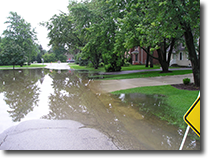Flood Control Response Policy
The Township Road District is assigned the care, maintenance and repair of the storm sewer system. When the Township Road District storm sewer, or access thereto, is found to be obstructed, it is the policy of the Township Road District to correct the problem and return the normal flow or system capacity as promptly as practical.

PURPOSE
It is the purpose of this policy to provide general guidance for responding to unusually heavy or sustained rainfall events, which can directly or indirectly cause localized flooding and surcharging conditions in storm sewers.
Download the Resident Flood Report Form.
PROCEDURE
General Guidelines:
Township Road District personnel are assigned as needed to monitor, correct, and where possible, to mitigate the effect of heavy rainfall conditions. This is done by inspecting locations which may be prone to blockages of storm inlets and culvert pipes by debris and by responding promptly to resident’s complaints of storm and sanitary sewer backup, including street flooding/buildup.
Heavy Rainfall/Flooding Response
- When storms are predicted by normal electronic media and/or conditions indicate storms are likely, the Foreman shall monitor media forecasting, including TV or weather radar service to which the Township Road District may subscribe. Also, he shall periodically check the fax machine, over which the County or other regional agencies often issue severe weather advisories.
- When heavy rainfall is forecast, the Foreman is responsible for ensuring that a sufficient number of crews are available to be dispatched to patrol the streets to clear blocked storm grates, culverts, detention basin outfalls, etc., and to respond to requests from residents and business owners for assistance.
- Generally, after intense or sustained rainfalls, the Township Road District receives calls reporting street, yard or basement flooding. If the rain continues or the storm intensifies, storm lines may become surcharged (i.e. the level of water in the manhole is higher than the top of pipe). The degree of flooding is dependent upon various factors, including, but not limited to: time of year, time of day, rainfall duration and intensity, soil and ground water conditions, the presence of frost, and the like.
- When checking for a possible plugged storm sewer, regardless of the time of day, two people must be in the company of one another for safety reasons (see Confined Space Entry Policy). At minimum, one manhole upstream and one manhole downstream of the suspected blockages must be thoroughly inspected. During heavy rainfall it is quite possible that there is an unusual amount of runoff being directed to the storm system to the point where the carrying capacities of the sewer systems are exceeded. In such cases, a number of upstream and downstream manholes will probably be surcharged. In most cases of obstructed sewers, surcharging will not be present within one or two downstream manholes of the reported problem. Manholes demonstrating surcharging not caused by blockages, will often, under careful observation show a swirling or whirlpool action indicating the presence of flow.
- Blockage is confirmed by inspecting the downstream manholes in the line until a manhole with normal flow is found. This manhole will be the place where the sewer flusher is set up because it is always desirable to flush upstream. This is done to facilitate the downstream outflow of any remnants of the blockage material.
- When sewer capacities are being exceeded because of heavy rainfall there is relatively little that can be done to correct the immediate situation. However, it is important to explain the reason for flooding to the resident, if he/she is at the flood site, and to the Foreman. In questionable circumstances, the sewer shall be flushed/cut as a precaution.
- If the complaint/problem is street flooding, due to an obstructed inlet(s), the inlet(s) must be located either visually or by metal detector.
- When the inlet is located, the debris must be cleared off the grate in order to facilitate drainage. The debris must be removed from the scene and not left on the curb or in the street.
- After the problem has been identified and, if possible, resolved, the field personnel shall radio the Foreman promptly and advise him/her of the means, location and time of problem abatement.
- The Foreman must keep careful, concise notes on the worksheet including but not limited to: address of problem, location, and type of problem; name and phone number of resident, if applicable; time problem was discovered/reported; means and time of resolution. In those cases which were reported by a resident, the dispatcher or field crew must make sure that the resident is notified of the outcome. Preferably, this will be handled by field personnel, but on those occasions when this is not practical, notification via telephone by the Foreman or Highway Commissioner will be necessary.
- In the event of an especially heavy rainfall event, a brief summary report must be written of the events of the flood control operation event. The report must be submitted to the Highway Commissioner within 24 hours after the rainfall has ceased or sufficiently abated. A major component of the report is a list of all locations where problems were encountered.
